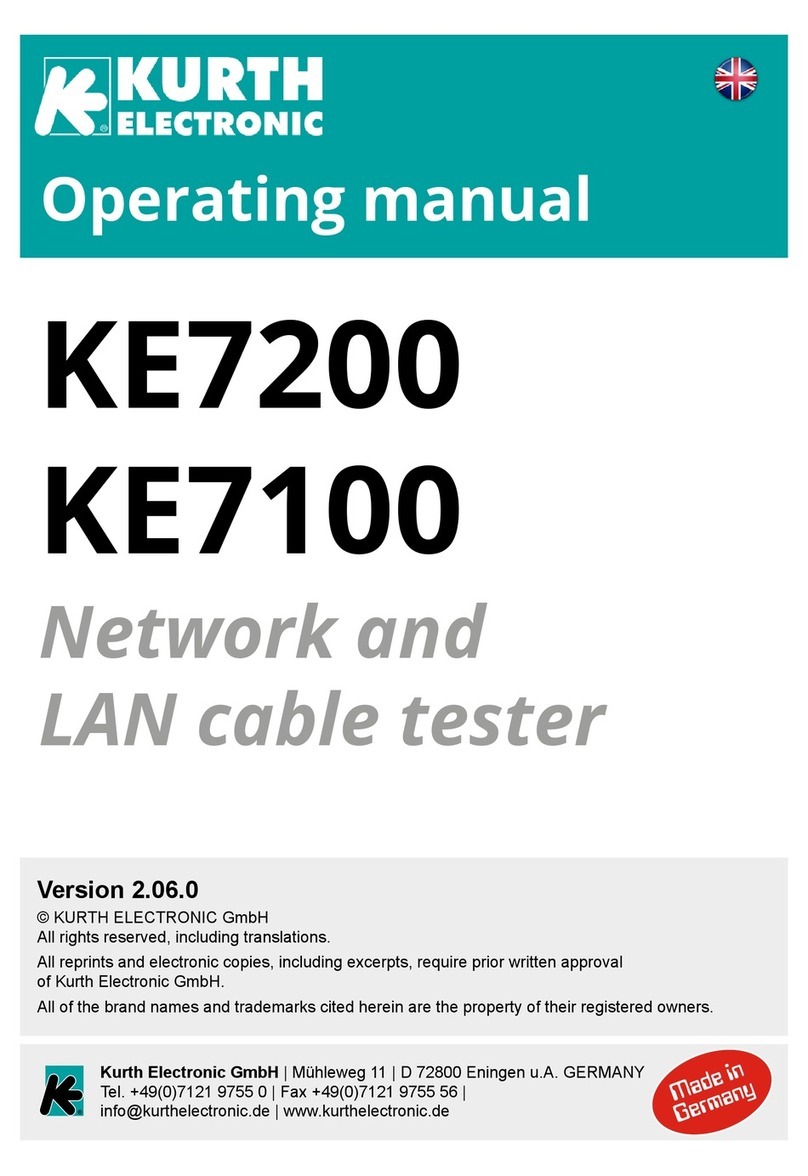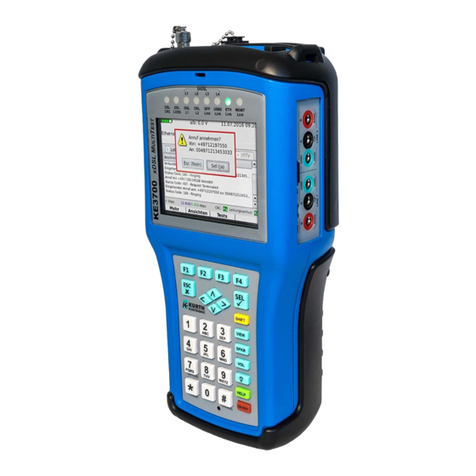
USER MANUAL
Warning - Hazard electrical shock, not intended for use on
energized wiring or circuits!
Please read and comply with these instructions prior to the initial operation of your
appliance. In case you do not adhere to this instruction manual, this may result in
damage on the appliance and cause dangerous situations for the operator and
other people.
PROBE 310/410
bundles in a distribution box or rack, the PROBE is moved flat above the bundle while
pressing the HIGH button. After the cables are located using the strongest signal, press
the LOW button to find the precise location of the desired cable. The highest signal is
always above the desired cable. When tracing shielded cables, connect the red test
lead to the shielding and the black test lead to ground (such as a protective conductor or
water line). If there is no shielding, connect across two different pairs within the cable. If
the shielding is grounded, it must be isolated at both ends. Do not connect across pairs
carrying Voice and pairs carrying Data.
B. Tracing twisted pairs: To trace specific twisted pairs and identify split pairs,
(non-contact tone receiver) connect one EASYTEST test lead to one wire and connect the other test lead to the other
The PROBE is a receiver and amplifier that detects tracing signals from senders like wire. The wires must be from the same twisted pair. This can be done by connecting to a
the EASYTEST and makes them audible over the built-in speaker. The green signal level wall jack or by clipping to the open cable end. While holding down the HIGH button, use
LED lights when the key 1 kHz tone from EASYTEST is detected among the signals on the PROBE to find the wire pair at the other end or at each distribution box. To determine
line. Interfering signals such as 50 Hz power hum and its harmonics will not trigger the the precise location, hold down the LOW button and find the wire pair with the strongest
green LED. The PROBE KE410 has a second, red LED that lights when an ISDN Basic signal. If the pair is twisted over the entire length, this specific pair will be found. If a wire
Rate signal is detected. This allows an active ISDN BRI (UK ) line to be detected in
0is disconnected along the length or if the pair changes to a single wire (split), several
places like distribution boxes. wires in the distribution box will carry the trace signal. This indicates a fault in the wiring.
US Version of PROBE KE310: Green signal level LED detect Frequency 577.5 Hz, You now have to go back and locate the fault. When the cable ends are open, use a
rather than 1 KHz. similar procedure; spread apart the wires and move the PROBE flat over them while
A flashlight function with a pure white light allows the identifying colors of the wires to be holding down the LOW button. When the test tip of the PROBE is guided across the
seen clearly in dark distribution boxes. The test tip of the PROBE consists of fiber- wires, the first wire of the correct wire pair displays a high level, a minimum level is
reinforced conductive plastic with a secure bayonet lock that allows easy on-site displayed in the middle, and the second wire again displays a high level. This distinctly
exchange without opening the unit. At the rear end of the PROBE there is a connection identifies the wire pair. If you cannot find a minimum level, either it is the wrong wire pair,
socket for an optional earphone (item no. 49600). The PROBE is turned on by pressing or there is a cable fault that may have been caused by an interruption, crossed or split
the HIGH or LOW buttons. The HIGH position is the most sensitive level for tracing pair. The EASYTEST transmits the trace frequency at approximately 12 dBm in lines with
weak signals. LOW position is used to identify the specific pair or wire needed. a terminal resistance that can be as low as 50 ohm. With the KE3xx/4xx/5xx/7xx/8xx,
you can transmit on energized telephone or data lines. The maximum cable length for
detection is 10 miles (no load).
EASYTEST KE300 - 800 (tone generator and line tester)
Maximum withstand voltage – not for test use: 2. CONT mode - continuity check/resistance check
CONT MODE (resistance test) 240 V AC - All devices; Turn on the continuity test mode by setting the sliding switch on the right side of the
TONE MODE (tracing tone) 120 V AC - KE3xx, KE4xx KE3xx/4xx/5xx to CONT. This applies a voltage to the tested line making it possible to
500 V AC - KE5xx, KE7xx, KE8xx sense line continuity, shorts or resistors up to 100 kOhm. The green LED CONT briefly
flashes when the test is activated or when the resistance at the test terminals is above
The EASYTEST is turned on and off by pressing the ON/OFF button. 100 kOhm. Depending on the level of the resistance, LED brightness will vary from light
After pressing the ON/OFF button, an audible tone is emitted to confirm that the device to dark. This allows the resistance to be estimated. This is a good way to check if data
has been turned on (only KE7xx/8xx) and the ALT and SOLID LEDs light briefly. For all cables are patched to terminating equipment. KE7xx/8xx replaces a beeper with a
other versions, the LEDs depend on the position of the three-position sliding switch: variable tone resistance check. The frequency of the tone depends on the resistance.
At 0 ohm (short), a tone of approximately 3 kHz is audible, and at 100 kOhm, a tone of
TONE = ALT LED flashes 500 Hz can be heard. This allows you to estimate the resistance. It is also possible to
DATA = Data LED shines weak green test capacitors and other components this way.
CONT = CONT LED flashes briefly
3. DATA mode link-blink function
The EASYTEST automatically shuts off after 90 minutes. To disable auto shut-off, press When the sliding switch of the KE4xx, KE7xx and KE8xx is set to DATA, the DATA LED
the ON/OFF button twice within one second after the device is turned on. A short shines dimmly green to indicate the mode is on. The yellow RJ45 test cable is used for
confirmation tone (only KE7xx/8xx) will sound to indicate that the timeout override testing. When it is inserted in a data port, the green DATA LED pulses brightly in sync
mode was activated. In addition, the SOLID LED flashes briefly. If you are in the SOLID with the generated NLP when the data port is patched to terminating equipment like a
tone mode, it is the ALT LED that flashes briefly. To Shut the Unit Off: Press the ON/OFF hub or switch. The normal link pulse signal (NLP) is transmitted in four second cycles.
button for more than 1.5 seconds. The shut-off tone sounds (only KE7xx/8xx), the ALT This is displayed on the EASYTEST with the green DATA LED and tone sequence
and SOLID LEDs light briefly, and the unit turns off. (KE7xx/8xx only). With conventional hubs, switches or routers, the link LED belonging
Quick display of the status of analog telephone lines, testing for voltage on digital lines to the port is turned on and off in the same cycle. This allows you to identify equipment
or alarm system wires, and much more. the status of analog telephone lines is easily port you are connected to.
checked by turning on the EASYTEST and inserting it into wall jack. This is easily done, ,
using the RJ11 connector (not included with the KE5xx) though it can also be done Low Batt - battery voltage level monitoring
using the optional TAE adapter, breakout adapter or by simply clipping the device onto
the wires using alligator clips. Idle telephone lines have voltages up to 70 V DC, and the When the unit is turned on and the internal battery falls below approximately 6 V,
POL LED shines brightly when the tester is connected. Red indicates a/b (T/R) the SOLID LED briefly flashes three times every 60 seconds to indicate low voltage;
inverted, green indicates correct polarity, i.e., a-wire, ring or negative on the red KE7xx/8xx also emits a warning tone. When SOLID flashing is activated in TONE
terminal. EASYTEST indicates with the red warning LED when the voltage on the line is mode, the ALT LED assumes this function. When 5V is reached, the EASYTEST
greater than 90 V. This information can also be used to identify the voltage at the ISDN automatically turns off.
U-interface. (92 – 96 V DC)
Starting at 100V, an alarm tone is generated by KE7xx/8xx to warn that the
voltage is too high on the line and can be dangerous.
Busy analoge telephone lines have voltages between 10 and 20 V DC, and the POL
LED is dim ´when the tester is connected. Red indicates a/b (T/R) inverted, green
indicates correct polarity. This is useful for determining if the line is busy or not in a
distribution box. The POL LED is orange when pure AC ringing voltage is present. With
the EASYTEST, any kind of voltage source can be checked for polarity, type of voltage
and its approximate level. The latest EASYTEST is high impedance in any mode,
meaning EASYTEST draws no line current to drive the POL LEDs.
1. TONE mode (send tracing tone)
When switching to TONE mode, the EASYTEST starts as default with alternating or
warbling tone frequencies. The EASYTEST has six easily selected tracing tone
frequencies. Briefly press the SOLID button (less than 2 seconds) to transmit a trace
frequency at precisely 1 kHz. If you press the button for more than 2 seconds,
a trace frequency of 2.9 kHz is generated. Additional pressing of 2 seconds switches
to 577.5 Hz.
Press the ALT button for less than 2 seconds to send alternating frequencies of
880 Hz/1 kHz. Press it for more than 2 seconds to switch to an alternating frequency
of 1.9 kHz/2.6 kHz. Another 2 seconds switches to a intermittent 577.5 kHz tone.
The high trace frequencies have two advantages. First, the human ear is the most
sensitive at 2,600 Hz and second, these two frequencies lie outside the signaling
frequency range of telephone systems. The LEDs to the right of the buttons indicate the
activated trace tone and can be seen from a distance. The trace signal can be injected
without interfering with active (voltage present) telecommunications and data lines.
The KE4xx, KE7xx and KE8xx are high-impedance for data signals, which makes it
possible to transmit trace signals on active telephone lines with ISDN and ADSL
systems without causing interference. The KE4xx further reduces possible
interference by sending sinusoidal signals.
A. Tracing cables: When tracing cables and wires, even within a wall, clip the black
test lead of the EASYTEST to ground and the red test lead to a single wire or a wire pair.
Select the trace frequency. The selected tone is transmitted and can be tracked without
contact using the PROBE for up to 60cm from the cable. Tone will be transmitted even
on shorted pairs to a maximum of 200 m. The PROBE is used to trace the cable. This is
done by pressing and holding the LOW or HIGH button. To locate a signal at a greater
distance or to trace a weak signal, press the HIGH button. In the case of large cable
KE800 only
Tracing coax cables with F-connector
Connect the coax cable to the F-Jack on the KE800. Start the trace tone by turning the
KE800 on. Then the units starts in ALT mode. To change to SOLID - press the SOL
button. To trace a coax cable take care that the far end is open and not groundet. If the
cable is groundet or connected on the far end you will not be able to get a trace signal.
This because the shield prevents this.
Test of fiber optic cables
In the fiber optic test mode the unit works as a visible laser source. To protect the user -
transmitted power is less then 1 mW, Laser Class 2.
Please do not stare into the beam!
The universal jack fits fiber plugs with a 2.5 mm ferrule. If your system is using 1.25 mm
ferrules - please use the 2.5 to 1.25 mm adapter, Art. No.: 1400070.
The jack is equipped with a ceramic spring to protect the ferrule to reduce the chance
that the plug will accidentally come out. The ceramic material protects the ferrule
against metallic contamination.
Start Fiber testing
Turn the KE800 on as described before. The Unit starts in TONE mode for copper
tracing. Plug the fiber with the ferrule into the universal jack. To turn on the laser source -
press the SOLID and ALT button together for > 1 Sec. The KE800 indicates the LASER
Mode by a turn-on tone and flashing ALT LED and Laser source. The LASER mode is
flashing at 1 Hz not modulated. By pressing the SOLID button the mode changes to
CW - not modulated. By pressing either the ALT or the SOLID button > 2 seconds, the
laser mode changes to modulated. The modulation frequency is audible and starts with
270 Hz. Release and press again changes the modulation to 1000 Hz and then to DC
again. If you use a power meter with demodulation feature at the far end to detect your
light, you will see the frequency in the display.
Regardless of the laser mode you will be able to spot light leaks from bad connections,
sharp bends and breaks, as well as identifying the far end of the connected cable.The
trace distance is more than 6 miles.
®
KE301 - KE401 - KE501 - KE701/ 702 - KE801
06/2012 Product design and specifications subject to change without notice. All trademarks belong to their respective companies.





























